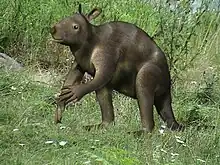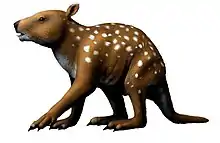Propleopus
Propleopus is an extinct genus of marsupials. Three species are known: P. chillagoensis from the Plio-Pleistocene, and P. oscillans and P. wellingtonensis[3] from the Pleistocene. In contrast to most other kangaroos, and similar to their small extant relative, the musky rat-kangaroo, they were probably omnivorous.
| Propleopus Temporal range: Pliocene - Pleistocene | |
|---|---|
 | |
| Scientific classification | |
| Domain: | Eukaryota |
| Kingdom: | Animalia |
| Phylum: | Chordata |
| Class: | Mammalia |
| Infraclass: | Marsupialia |
| Order: | Diprotodontia |
| Family: | Hypsiprymnodontidae |
| Genus: | †Propleopus Longman, 1924[1] |
| Type species | |
| Triclas oscillans | |
The species assigned to this genus are:
- Propleopus chillagoensis Archer et al., 1978
- Propleopus oscillans (De Vis, 1888) (type species)
- Propleopus wellingtonensis (Archer & Flannery, 1985)[4]
References
- Longman, Heber A. (1924). "Some Queensland fossil vertebrates". Memoirs of the Queensland Museum. 8: 16–28.
- De Vis, C.W. (1888). "On an extinct genus of the marsupials allied to Hypsiprymnodon". Proceedings of the Linnean Society of New South Wales. Linnean Society of New South Wales. 13: 5–8.
- Wroe, S. (1996). "An Investigation of Phylogeny in the Giant Extinct Rat Kangaroo Ekaltadeta (Propleopinae, Potoroidae, Marsupialia)". Journal of Paleontology. 70 (4): 681–690. doi:10.1017/S0022336000023635. ISSN 0022-3360. JSTOR 1306529. S2CID 86211685.
- Archer, M.; Flannery, T. (1985). "Revision of the Extinct Gigantic Rat Kangaroos (Potoroidae: Marsupialia), with Description of a New Miocene Genus and Species and a New Pleistocene Species of Propleopus". Journal of Paleontology. 59 (6): 1331–1349. ISSN 0022-3360. JSTOR 1304948.
- John A. Long et al.: Prehistoric Mammals of Australia and New Guinea. Johns Hopkins University Press, Baltimore 2003, ISBN 0-8018-7223-5.
- "Propleopus (Genus)". ZipcodeZoo.com. Archived from the original on 2012-01-26.
- THE GIANT RAT-KANGAROO PROPLEOPUS OSCILLANS (DE VIS)
Wikimedia Commons has media related to Propleopus.
This article is issued from Wikipedia. The text is licensed under Creative Commons - Attribution - Sharealike. Additional terms may apply for the media files.



